HISTORIC DIVING
EQUIPMENT & SUPPLY Co.,
1972 U.S. NAVY MK V HELIUM DIVING HELMET
Formerly Navy Diver’s – From Seaman to Commander
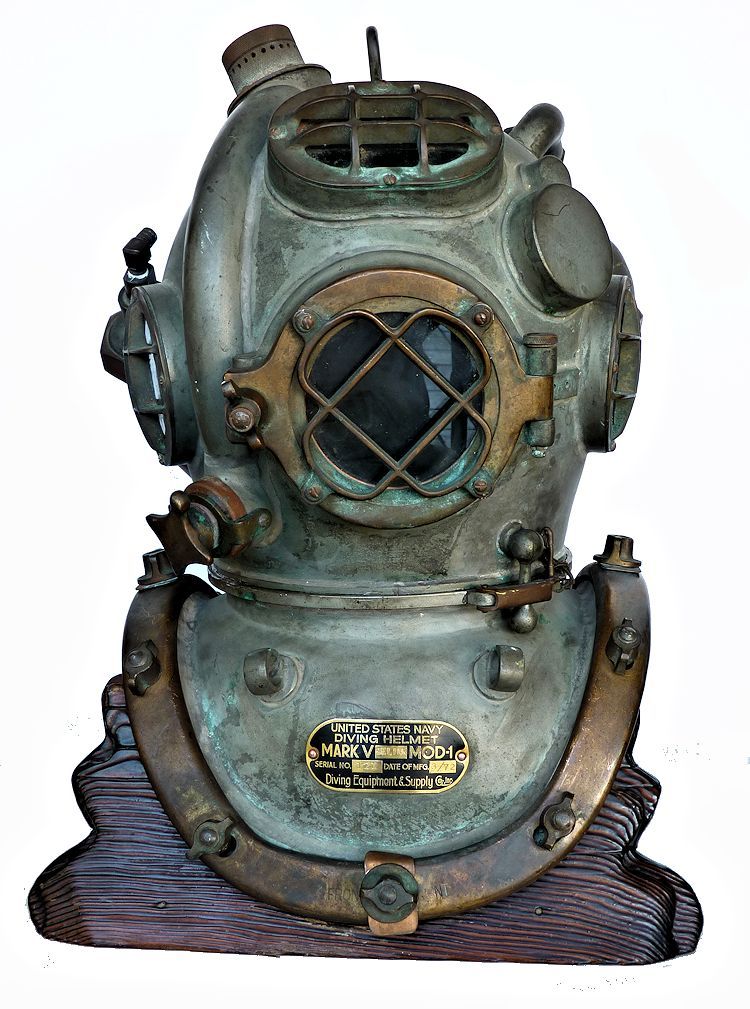
Owned for the last 42 years by a Navy Officer, formerly
an Enlisted man TOTAL WEIGHT:
105 lbs SERIAL NUMBER: 121
DATE: 3 – 1972<STAND
NOT INCLUDED
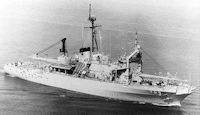
Presented
is a U.S. Navy MK V HELIOX dive helmet that was made by the Diving Equipment & Supply Co. DESCO verified the
helmet with their records which show that it was made in March, 1972 and sent directly to the USS Brunswick (ATS 3) directly before her commissioning. This ship was was an Edenton-class
salvage and rescue ship in the service of the United States Navy from 1972 until her decommissioning in 1996.It now comes from the Estate of a career Naval
Officer who joined the service as a young man in 1966 as a seaman recruit. During the course of his 29 year career, he rose
through the enlisted boatswain ranks, became a commissioned officer and went to Diving & Salvage School in Panama City,
FL. He advanced in rank through first lieutenant, diving officer, navigator, and executive officer. During his Navy career, he served in surface warships, submarine rescue
ships and small craft in Vietnam. He retired in 1995 as a full commander and then worked for management consultants,
Booz Allen, in support of the Royal Saudi Navy. He died in 2005 at the youthful age age of 59. HELMET
& MARKINGS: Authentic 12 bolt, 4 light Diving Equipment & Supply Co. MK V Heliox helmet
dated 3/1972 with serial number 121 on the maker’s tag. The
serial number is also stamped on the inside of the breast plate and bonnet’s threaded rings. with the serial number 121 stamped on each. There are pencil notations on the back of the bonnet, “Red diamond”,
but wihout paint. Being a post WW II helmet, there is no inspector’s stamp. CONDITION:Considering
its 42 years age and use, it is in absolutely outstanding condition overall. There are few dents or
abrasions other than from storage. There is no evidence this helmet has been dived and the fittings inside the bonnet
are bright and shiny. We consider it “New Old Stock” (NOS). The air vents are all intact. The right
side chin relief valve, spit cock handle, front door wing nut, all turn. The speaker housing is empty, but two comm
wires are present.
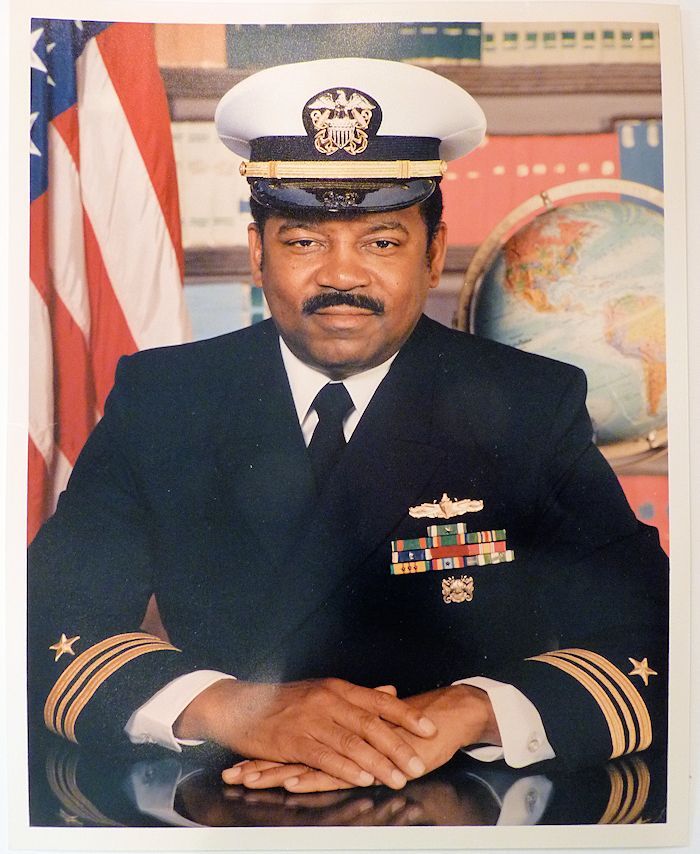 Photo
Photo
of A.N. Roberts, Jr. as a lieutenant commander (Included) FORMER OWNER’S
BIOGRAPHY IN BRIEF:CMDR
A.N. ROBERTS, Jr., U.S. NAVY Alvin N. Roberts,
Jr. was born on September 3, 1946, in Waycross, GA. His parents were the late Alvin Roberts, Sr., and Francis Walker
Roberts. He attended Waycross Center High School graduating in 1965.Commander A.N. Roberts,
Jr. enlisted in the United States Navy in May 1966 as a seaman recruit. During his enlisted service, he served as a
Boatswains Mate on board USS JAMESTOWN (AG TR-3), USS MARS (AFS-1), and in small craft in Vietnam, USS NORTHAMPTON (CC-1)
and USS LEAHY (CG-16).Boatswain Mate Roberts
attended college at nights and through extension courses. Upon his graduation from Florida A&M University in 1973,
with a B.S. in education, Boatswain Mate Roberts continued his education at Florida Atlantic University earning
a Master’s Degree in Education. In February 1975,
he was commissioned an ensign and was sent to Navy Diving and Salvage School in, Panama City, FL and then to
Surface Warfare Officer Basic School in Newport, RI and Communications Officer School.He served as First
Lieutenant, and Diving and Salvage officer on board USS BRUNSWICK (ATS-3) at Pearl Harbor, Hawaii and did interim duty as
Executive Officer on the USS TWAKONE (ATF-114).In 1979, Cmdr. Roberts
graduated from Surface Warfare Department Head School, Norfolk, VA. He completed departmental tours as Engineer Officer
on boards USS TALBOT (FFG-4) and First Lieutenant on board USS CANISTEO (AO-99). Subsequent assignments
included Commander Training Command United States Atlantic Fleet from 1983 to 1985, serving as Seamanship, Amphibious, Navigation,
Supply Training Commands as Curriculum Manager, and Scheduler. From 1985 – 1987 he was assigned to Commander Amphibious
Group Two Cmdr. Roberts attended the United States Marine Corps Command Staff College in Quantico, Virginia
and the Prospective Executive Officer School in Newport, RI. prior
to reporting on board the auxiliary repair ship, USS VULCAN (AR-5). He retired in 1995 as a full commander with 29 years total enlisted and commissioned service. Commander Roberts’ awards include the Navy Commendation Medal and Gold Star, Navy Achievement
Medal, Sea Service Deployment Ribbon, Good Conduct Medal, Battle Efficiency , Ribbon, Navy Unit Citation Ribbon, National
Defense Ribbon, Vietnam Campaign Medal with two stars, Vietnam Service Medal, and Meritorious Service Ribbon. After his service career, he joined the management firm of Booz Allen as an associate overseeing
training related activity in support of the Royal Saudi Navy.
CDR Robert’s died on May 16, 2005 at the youthful age of
59.
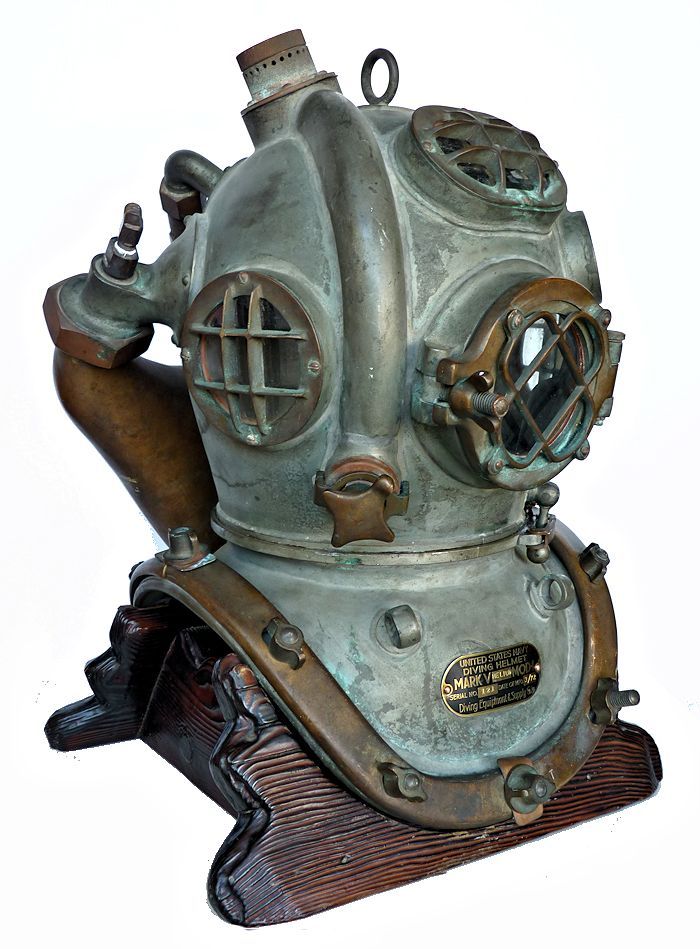 |
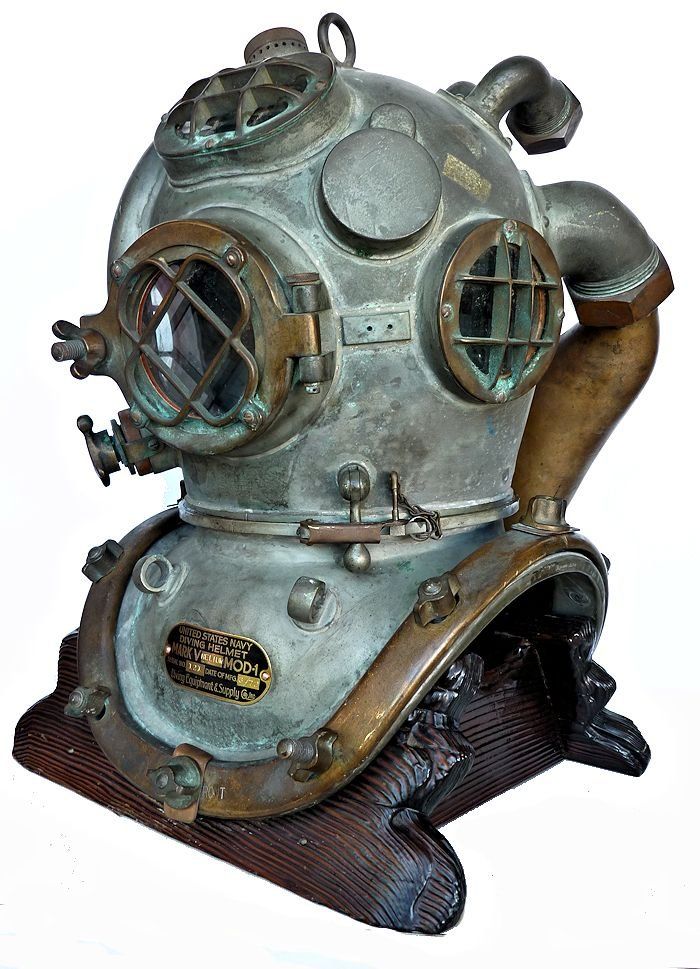 |
Three quarter views of the right side of the
1972 Heliox helmet over the left side Like
all old diving gear, this is being sold for DISPLAY ONLY. It should not be dived without having passed inspection by
a certified dive shop. The
place to go would be the company who made this hat, now known worldwide as DESCO. See
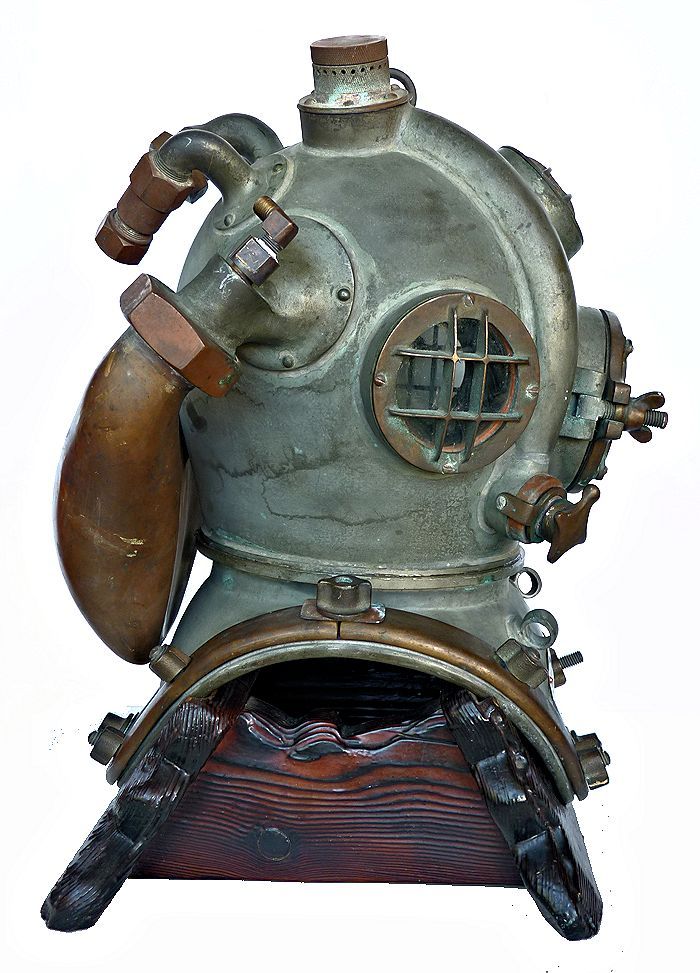 |
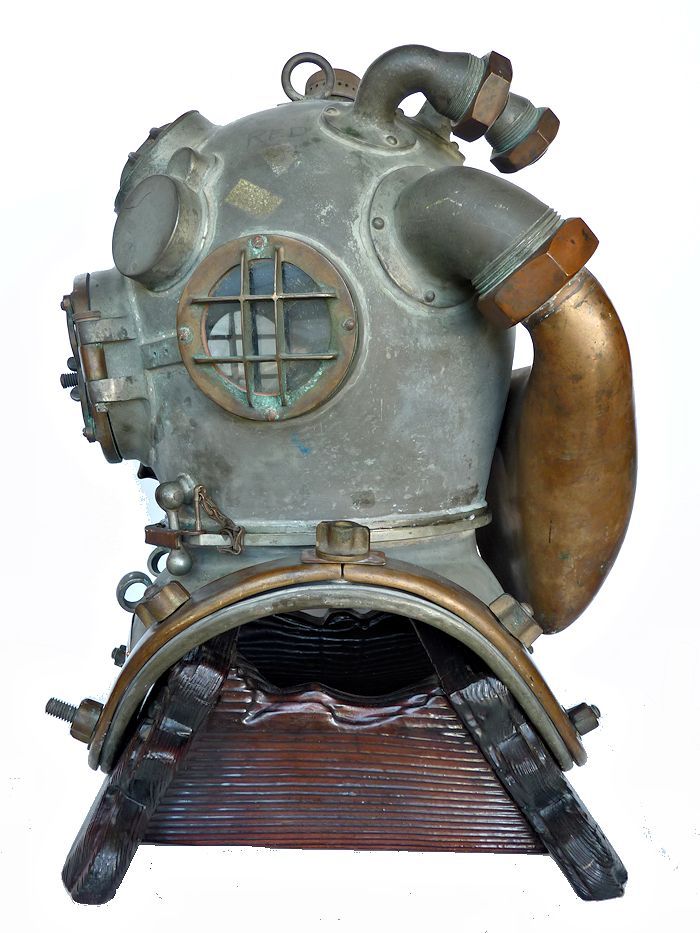 |
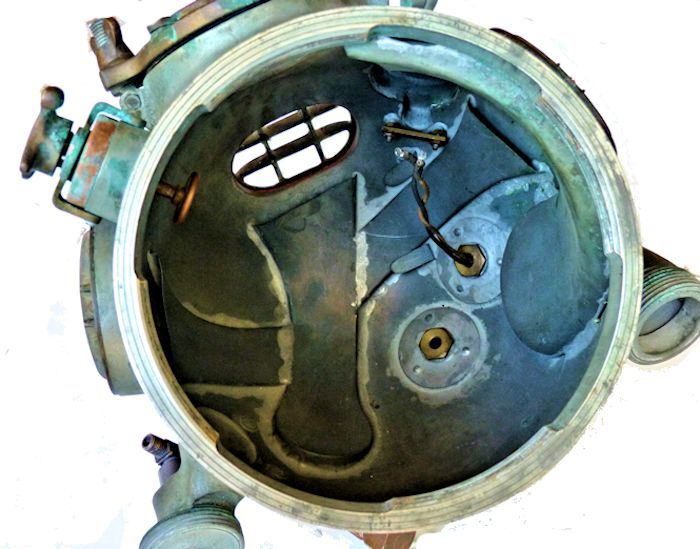 |
 |
Inside of helmet shown over bottom of breast plate
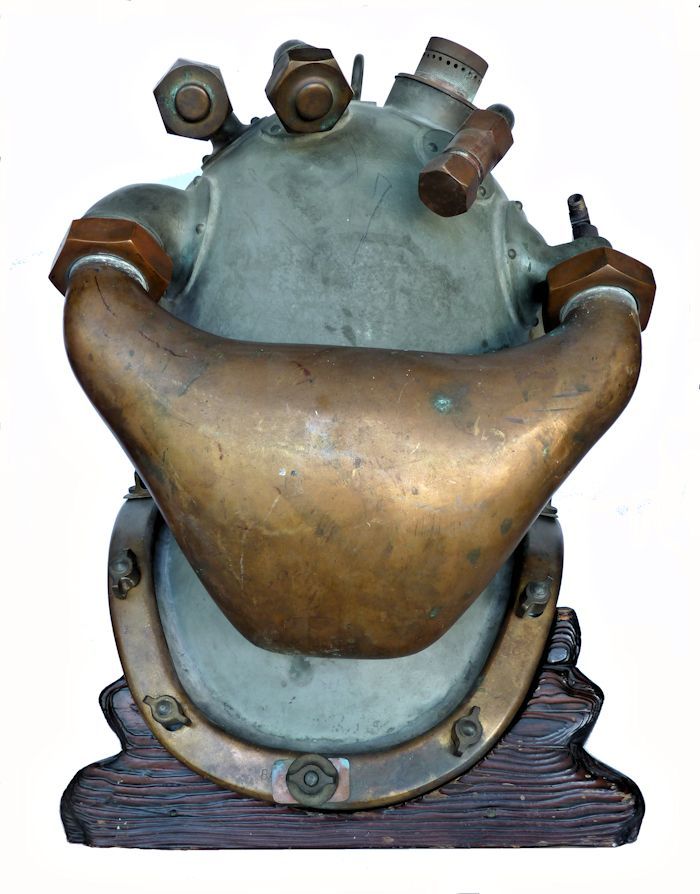 |
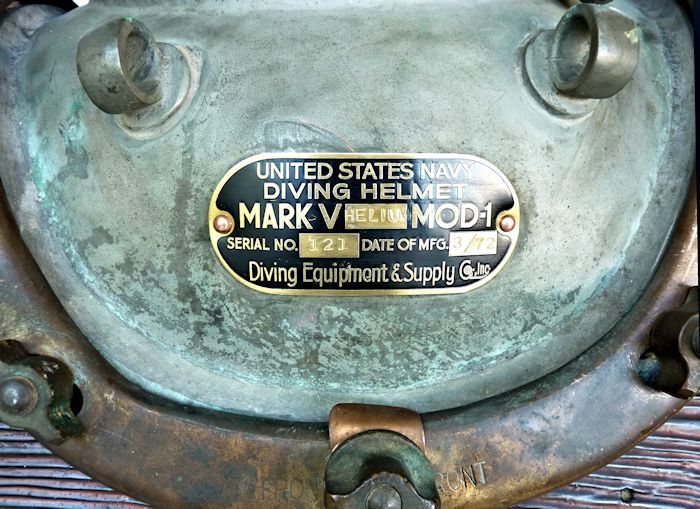 |
Back of
1972 helium helmet showing the cannister shown over the maker’s tag
Right side of the 1972 DESCO MKV helium dive helmet shown over the left side BRIEF HISTORY of NAVY
MK V DEEP SEA DIVING DRESS: By 1915, the Bureau of Construction and Repair had designed
the MK V Diving Helmet which seemed to address many of the problems encountered in diving. This deep-sea outfit was designed
for extensive, rugged diving work and provided the diver maximum physical protection and some maneuverability. The 1915 MK V Diving Helmet had an elbow inlet with a safety
valve that allowed air to enter the helmet, but not to escape back up the umbilical if the air supply were interrupted. Air
was expelled from the helmet through an exhaust valve on the right side, below the port. The exhaust valve was vented toward
the rear of the helmet to prevent escaping bubbles from interfering with the diver’s field of vision.By 1916, several improvements had been made to the helmet, including
a rudimentary communications system via a telephone cable and a regulating valve operated by an interior push button. The
regulating valve allowed some control of the atmospheric pressure. A supplementary relief valve, known as the spitcock, was
added to the left side of the helmet. A safety catch was also incorporated to keep the helmet attached to the breast plate.
The exhaust valve and the communications system were improved by 1927, and the weight of the helmet was decreased to be more
comfortable for the diver. After 1927, the MK V changed very little. It remained basically
the same helmet used in salvage operations of the USS S-51 and USS S-4 in the mid-1920s. With its associated deep-sea dress
and umbilical, the MK V was used for all submarine rescue and salvage work undertaken in peacetime and practically all salvage
work undertaken during World War II. The MK V Diving Helmet was the standard U.S. Navy diving equipment until succeeded by
the MK 12 Surface-Supplied Diving helmet in February 1980, which in turn was replaced by the MK 21 in December 1993.
